
The original fusion. In the Bo-kaap — a neighborhood in Cape Town — the locals aren’t trying to be trendy or modern; fusing cultures into their cuisine is their heritage. Above are the colorful houses of the Bo-Kaap
Walking down Wale Street in the Bo-Kaap there are fragrant spice shops, Muslim book stores, leather workshops, smiling locals and colorful houses in teals, purples, blues, pinks, oranges and greens. Today I’m visiting the home of a local woman named Amina. As Amina has a husband and five sons, she’s used to cooking large meals for hungry mouths.
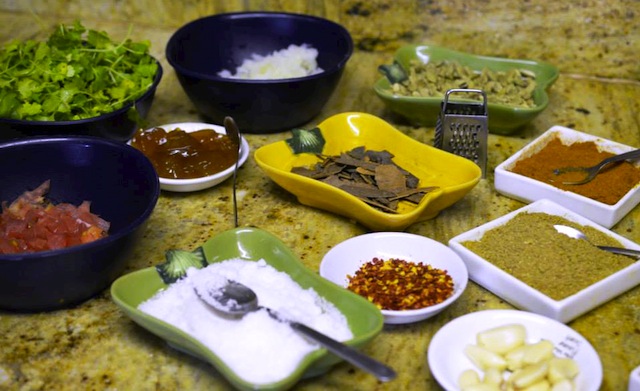
Spices for the chicken curry laid out on the kitchen counter
The term “Cape Malay” references the people and their flavorful, spice-focused cuisine, while the word “safari” is symbolic of the cultural journey of the traveler through food. Cape Town’s Cape Malay people were the first to bring Islam to South Africa, which is still a strong element of the Bo-Kaap community. These people were brought over from Maritime Southeast Asia — mainly from Java in Indonesia — which was a Dutch colony until 1945. During this time, these people were brought over to South Africa as slaves for Dutch masters.
This is important to know when understanding the idea that when you enter a Cape Malay home you’re sharing a blessing. During the time when these people were slaves they were not allowed to congregate or practice their culture or religion; however, on Sundays when the masters and their families would go to church the slave community would hold secret meetings where they could be themselves, celebrate their heritage and eat together. Sometimes a slave would not be able to sneak away for the Sunday meeting.
When this occurred, those in attendance would save leftovers and bring it to the missing peoples’ homes. This is also why when you dine as a visitor at a Cape Malay home you’ll receive a doggy bag, as once you enter the food is yours, as well.
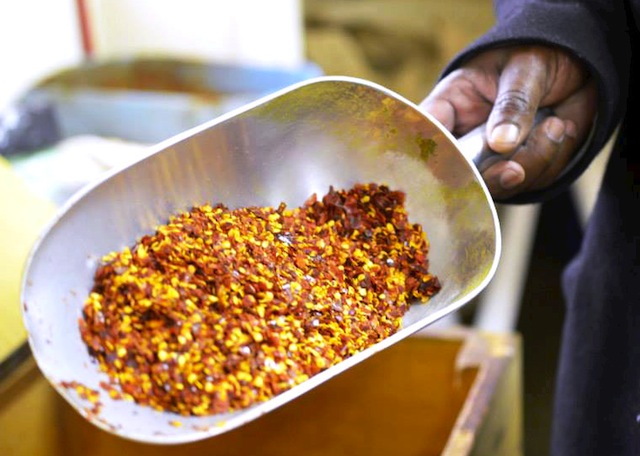
Perusing the Spices at Atlas Trading Co. in the Bo-Kaap
By creating this experience for the women of the Bo-Kaap, Andulela Tours is not only creating an interactive local experience for visitors, but also helping to empower women. It allows these females to be proud of their strong cooking skills, while having the chance to connect with their cultural background and also learn about a new heritage through the guest. Moreover, as the company often targets families in need of financial support you’re helping to sustain a family through the experience.
Today, I’m in the home of Amina, a Muslim woman of Malay heritage. Her house is warm and inviting, with lived-in couches, children’s artwork hanging on the fridge and the aroma of something cooking in the kitchen. Today she will be teaching us about the cuisine through a cooking class in her home, where our group will prepare samoosas, chicken curry, sambal and roti while learning about the colorful and flavorful ingredients.
“The main spices used in Cape Malay cuisine are turmeric, masala and chili powder,” explains Sab. “From there corianders, fennels and other spices are added to enhance savory dishes. In desserts and sweets, the focus is on cinnamon, star anise and cardamom.”
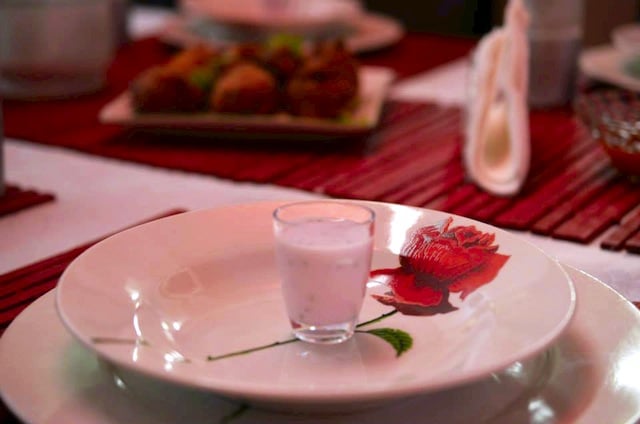
Cape Malay cuisine focuses on flavor over heat. Because it fuses together a number of backgrounds, recipes vary by individual depending on their heritage. What makes the cuisine special, however, is that you’ll always find five or more spices in one dish.
To begin the experience, we sit at Amina’s dining room table for a welcome drink and appetizer, a common practice for locals welcoming visitors. Two heaping plates of chili balls — made with pea flour, regular flour, spinach, onions, potato and spices — are steaming hot from two porcelain plates, along with a welcome drink of falloda, a concoction of rose, syrup and tapioca seeds that’s light and refreshing.
“It’s time to start the chicken curry,” says Amina with an excited smile.
The main different between Indian and Malay curries is the amount of heat. While Indian curry tends to be a fiery red and extremely hot with much chili pepper and paprika, Malay curry has more of a medium heat with a slightly sweeter taste.
Amina has already braised the onions with cardamom pods for the curry, so she instructs me to add in the spices — a teaspoon each of salt, cumin, coriander, masala and a half teaspoon of turmeric. Next, we dump in a big bowl of potato chunks and begin to stir. If that wasn’t enough spices, the chicken is simmered with crushed garlic, ginger, chili and curry leaves.

The Art of Samosa Folding
While this is cooking, we begin making the samosas. I have often wondered how these bite-sized savory snacks are so perfectly packaged, and I find out as Amina instructs me to drape a long rectangle of samosa leaf — similar to phyllo dough — over my open palm, with the palm side of dough ending at my middle finger.
I take the left lower tip of the dough and fold it to the left to create a triangular corner, then take the bottom right corner to fold it up and create a pocket. This pocket is where you can stuff the samosas with whatever you please: Meats, vegetables, cheeses, sauces and anything else you can imagine, especially in Malay cuisine where different cultures blend together and recipes get creative. Today we’re stuffing them with minced beef mixed with onion, coriander leaves, salt, masala, curry powder, turmeric, crushed chilies, crushed ginger and crushed garlic, an exorbitant blend of flavorful spices in true Malay style.
Once the pocket is full I press it gently with my fingers to flatten and evenly spread the ingredients inside. We continue folding the dough in a triangular fashion until it’s almost complete. Then when there’s just one fold left a sticky mixture of flour and water is used to hold the samosa closed into a tight triangle before being fried in a pot on the stove.
At one time the Bo-Kaap was a completely Malaysian community known as the Malay Quarter; however, today, you’ll find people from all over the world wanting to live in the physically and figuratively colorful neighborhood. That being said, you’ll still see a very strong Malaysian and Muslim culture, with Arabic being spoken, Muslim book shops and family Malay recipes that have been passed down still being used.
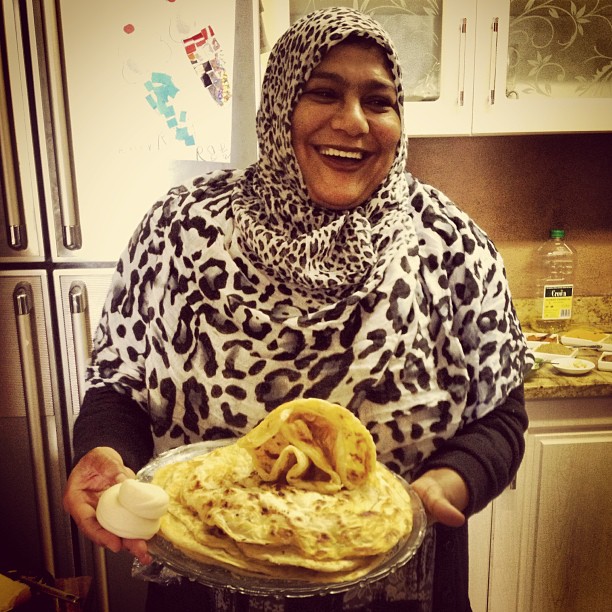
Anima holding both unfinished and finished roti
In Malay culture, meals are all about coming together. Typically, there is a starter before the main course, with the focus of the meal being the family interactions.
“Many people in the community have large families,” explains Amina. “We have at least two meals per day where we eat all together. It gives family members a chance to connect, chatting for hours.”
The roti is the next dish to prepare. Roti is a thin, moist, chewy bread that’s very easy to pull apart. It’s made by taking small tennis ball-sized hunks of dough and flattening them out, rolling them thin with a rolling pin. From there, butter is spread onto the flattened dough and sprinkled with flour. Next, the dough is rolled into a long and slender snake shape before being spiraled into two-tired mound (as shown above). Finally, the mound is fried in a skillet and formed into a pancake shape.
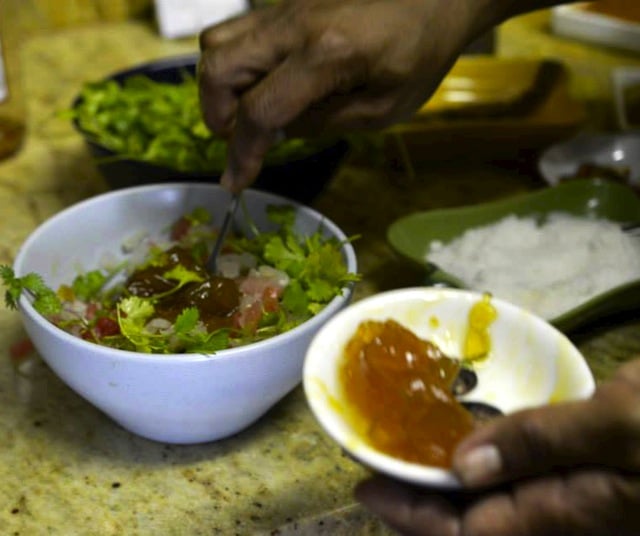
Making Sambal
The roti is what you eat with the curry and sambal, a mixture of tomato, onion, sweet vinegar, apricot jam, chillies and coriander leafs that has a balanced sweet and spicy taste. I ask for mine extra hot, and Amina gladly obliges by adding extra chili.
We sit at the table, and Sab shows us how to properly eat the roti. The first way is to put the curry and sambal onto the roti and roll it up like an enchilada. Alternatively, one can fold the roti up like a napkin with four layers and dip it into the curry and sambal using your right hand (the left is used for toilet matters only).
“South Africans love to eat with their hands,” Sab says. “It makes the food taste better. Just make sure not to bite into a cardamom seed or cinnamon stick. They’re great for adding flavor, but unpleasant to bite into. Biesmillah!”
Biesmillah means “In the name of Allah.” Alternatively, you an say “inshalah,” which means “God willing.”

How to properly roll a chicken curry-filled roti
With the first bite my taste buds begin dancing, a choreography that’s not quite unison but still manages to be in sync. While the hot chili of the sambal tingles my lips and rests pleasantly on the back of my tongue, the earthiness of the turmeric hits the center.
Then there’s the buttery taste of the roti, the spiciness of the ginger, the nuttiness of the cumin, the citrus twang of the coriander and the complexity of the masala all so different, but seamlessly blending together in the perfect fusion, which is the basis of Malay cooking.
Suddenly, Amina’s husband comes home from work and greets us.
“Your wife is a splendid cook,” I say, my mouth full of chicken and potato and my fingers sticky with curry sauce.
He smiles and points to his protruding belly. “Yes, she is. Why do you think we all look like this?”

Koeksister, a Traditional South African Dessert
We end the experience with local Rooibos tea and a sugary dessert called “koeksister,” which is also a popular breakfast food on Sundays in Malay culture. The sweet is a type of syrup-drenched fried doughnut that tastes like honey. Biting into it, it has a crunchy texture, and when the dough breaks the thick syrup seeps out and coats my tongue. Nothing could be more sweetly satisfying.
To me, this is what travel is all about. Not just photographing the sights, but interacting with the locals which, as Sab says, are the real attraction. Cape Town itself is unlike any other city in South Africa — known as the “Mother City” because of its infusion of cultures — and the destination’s Malay heritage is well worth exploring.

Jessica Festa is the editor of the travel sites Jessie on a Journey (http://jessieonajourney.com) and Epicure & Culture (http://epicureandculture.com). Along with blogging at We Blog The World, her byline has appeared in publications like Huffington Post, Gadling, Fodor’s, Travel + Escape, Matador, Viator, The Culture-Ist and many others. After getting her BA/MA in Communication from the State University of New York at Albany, she realized she wasn’t really to stop backpacking and made travel her full time job. Some of her most memorable experiences include studying abroad in Sydney, teaching English in Thailand, doing orphanage work in Ghana, hiking her way through South America and traveling solo through Europe. She has a passion for backpacking, adventure, hiking, wine and getting off the beaten path.








